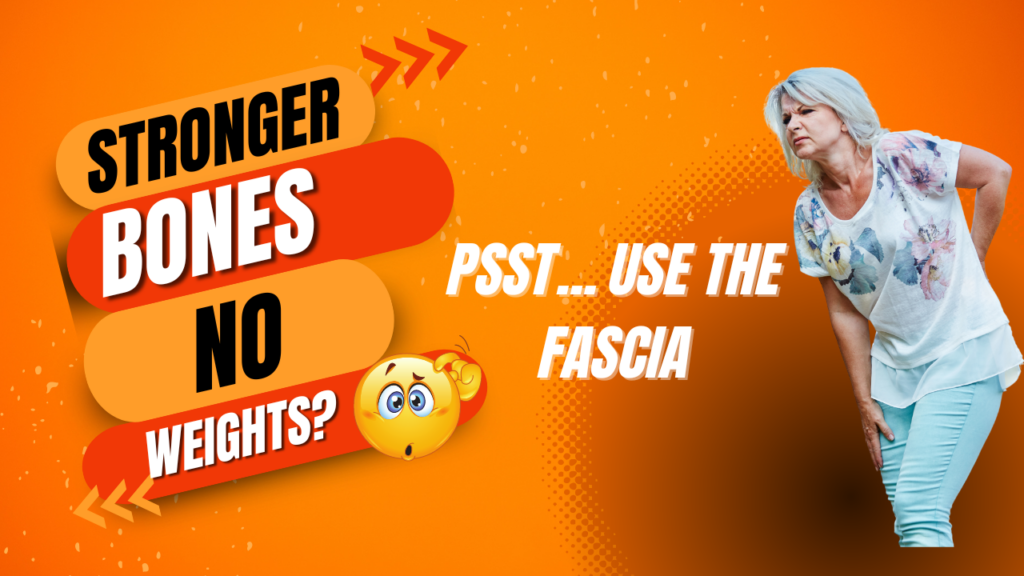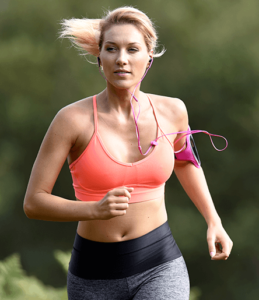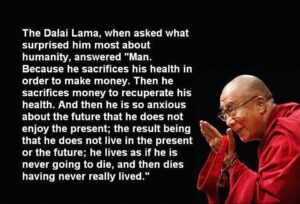
Click on the image to watch
So you’re at the doctor and they tell you, “Unfortunately you’ve got osteoporosis. And they say, “You need to lift weights and go walking so you increase bone density to raise your T-score and Z-score.” Okay, good. There’s one problem with that and no of offense to doctors, but this is not their job. They’re going to give you the information that you basically know. Go to a gym, sit in the weights, do some classes, go walking, be safe. Maybe give some precautions like don’t be ballistic. Jump up and down. Don’t do folding and twisting, stuff like that.
No dis to doctors, but there’s a lot more you can do, a lot more you can do safe for osteoporosis without weights. So I want you stay tuned to this video. I’m go through the reasons why and what you can do. I’m Ekemba Sol I’m a solo a therapist and I’m trainer, which is kind like a physical therapist, but more, and that’s all under the osteopathic model of which I’ve been studying for, I don’t know, 17, 18 years.
So I got into this field after a lot of issues with my body and seeing how the regular way of doing things wasn’t working. So I dove into the holistic osteopathic model and I found great success and so I want to impart as much as I can of this knowledge in this format to you.
If you’re interested in finding out more about holistic fitness, holistic health, then subscribe to the channel. If you like this video, give it a thumbs up and then share with your friends.
Again, I want to be very clear, I have nothing against doctors. I totally believe them. There’s just two ways of thinking. There’s a allopathic way of doing things and a osteopathic or holistic way of doing things. You’re either treating a symptom or you’re doing the etiology, the cause. Both are good. You just have to understand what you’re getting with each.
And in this case, the allopathic symptom one is not the best for knowing how to lift weights for osteoporosis. That’s not part of their program. Just like learning about medicines is not part of my program. Don’t come to me for medication. I have no clue.
When they tell you to lift weights, they’re thinking as much as you do. Oh, if you go to a gym and pick up things that are heavy and move them, you get tension in your body, which helps with bone density. They’ve done studies, and again, I like studies, but studies are just a part of the information, not the whole information.
By just going to the gym like anybody, but even more osteoporosis, you’re not getting a full body workout. You may work different parts of your body but you’re not getting a full body workout. There’s a lot of different ways your body can move and that needs to move that’s not being encompassed in a gym. On top of that, you’re kind of left on your own. Maybe you have a trainer, but generally the trainers are in AGMR more base level and they put you in the same machines that you do. Tell you how many do, crack a couple of jokes. I’m exaggerating a little bit, but it’s not too far from the truth.
Maybe you go a little bit further than that. Okay, maybe you realize, okay, I want to do more than just go to the gym and do my walking. You look up and you find a study which there are, you found out that the power plate and Nordic walking are really good for osteoporosis, which they are. They are fantastic ways to micro stimulate the bone. But you can’t stop there. You can’t stop at one piece of information and think you have all the information because by just doing those micro stimulations with the power plate and with the Nordic walking, you’re not respecting the soft tissue and the soft tissue always wins.
So when I say the soft tissue always wins, I mean the soft tissue is the intelligent part of the body. When I have information from my brain to my body, it goes to the soft tissue without the bones, specifically the ligaments and joints. So I tell my body where I am so you don’t tell the body where it wants to be. It just flops around and does what it thinks it should do. That’s how you get bad posture. That’s why when you go to a chiropractor that doesn’t have intricate knowledge of how to retrain your soft tissue and it just crack your bones back in place, eventually it goes back out of place, which is why you have to go back the next week and the next week and next week because the soft tissue says, I don’t think so. You have to come back over here.
And so when I talk about soft tissue, we’re leading to the most important soft tissue, your fascia because your fascia connects everything I’ve been talking about. Your bones, your ligaments, your joints, your muscles. All is one fascia that from in utero till now is split into thousands different directions, but it’s one thing and it’s alive. It’s not just a white piece you cut off when you’re cutting your meat. It’s alive. It has a bunch of different jobs and it helps your body to be balanced.
So how does your body want to be balanced? Well, I’ve talked about this in the video before on osteoporosis and bending over. I won’t go too much into it, but I’m going to do a quick recap just for the purpose of this video. You want to be bounced in two main ways. You want to have a good plumb line, which means you want your ear, shoulder, hip, knee, and ankle line up and straight. You want to have good gravity line, which is an inverse four degree cone that starts below your pubic bone, it comes out that you should be able to maintain. These two are important because now your body has better forces going through the body. You don’t get weird forces that go in weird places causing weird injuries.
But for the sake of this video, the most important part of being balanced is having your trabecula and your bone aligned. What’s a trabecula? The trabecula are forces or lines inside the bone, like rebar is in a building, in this building. The rebar are in the building needs to be lined up so the forces go through it so the building can stay around for a long time. It’s the same thing in your body. The only difference is we move. Right now, buildings don’t. So I want to have those trabecula lined up.
Most people are out of bounds, which means their trabecula is not lined up. And so I move around, the forces don’t go properly through the trabecula. They reorganized in a different way, a bad way in your bones, which is why you start to get weird forces through your body. And for osteoporosis, that is not a good thing because now you’re putting weird forces through your body, technical term, which can cause yes, bone production, but not in a good way because you’re putting forces through your body and you’re unbalanced. Yes, your bone’s getting stronger, but your body’s also getting more unbalanced.
So you want to realign your body first. Well, how do you do that without lifting weights? You can use the fascia. So you can use techniques, in my case, myofascial stretching and GPS global postal stretching to use the fascial chains to line your body back up. Because that fascia surrounds the bone in periosteum, which connects to a muscle tendon, which connects to muscles, I can use that force through my muscles, through the muscle tendon to the periosteum to pull my bones back in place so I’m nice and balanced.
As I pull myself back in balance, I also get tensile forces through the fascia. So imagine you have a little tube and you pull it, it becomes tighter, right? Well, as it becomes tighter, that bone’s inside there, it now squeezes the bone. As it squeezes the bone, you get bone production. So now you’re realigning your body and producing bone production at the same time. It sounds like a win-win to me.
Are you stuck right now in the basic wave of doing your osteoporosis treatment and just going to a gym and maybe walking, but you kind of feel like there might be something more? Well, let me know what you’re doing and stay tuned for more.
So as I mentioned before, you want to work all your muscles, all your soft tissue so that all your soft tissue can help keep your body bounce. So when your body moves around, the forces move through nicely, your bones get stimulated, but at the same time, you’re not pulling yourself out of balance, which can cause more injuries even in regular people, but more for osteoporosis. So you want to work all of them.
So how do you work all of them? Well, you got around 600 muscles, but these muscles do different things, they go different directions, which means the fibers inside the muscle go different directions, which means you need to have different postures for even the same muscle. The example I give in these videos all the time is your glute mead. Your glute mead is your hip muscle. Your hip muscle has three separate fibers. You have an anterior front one, a middle one in the middle, and a posture back one. You need put each one intention to tell your body, Hey, I want to use this one more. But at the same time, you want to respect the rest of your body.
Respect the body. What does that mean? Well, the body’s holistic. It’s interdependent and interconnected. It means everything works together and it’s connected together. So as you work your hip muscle, at the same time, you need to respect the fact that via fascia in that hip muscle, you have a connection all the way down to your toe, up to your head, to your tailbone, out to your hand. You need to work all three fibers. So you need to do this in a fashion that respects the body. By doing so, you train your hip muscle, but at the same time you train your entire body. This is what I’m talking about, about training all your muscles. Now you can do the same thing through tendons, ligaments, joints. There’s thousands of different exercises. You don’t have to do them all that you want to do for you. You want to find the ones that are appropriate for you.
The big takeaway here is like most things I try impart on this channel is that there’s more than meet the eye. There’s this base load of information that we have for health and fitness, but below that, like the iceberg video, there’s little bit of information here and down below, there’s a ton more stuff that’s going on. Know where your information is coming from. And know what you need to do for you.
So if you’re interested in finding out more, I have some options for you by working with me. First, you can just join my free Facebook group. I forget what it’s called, but it’s like strength, mobility, and flexibility, there it is, for active people over 40 generally. And here I am more interactive. So I want to talk with you. I do many trainings, I do masterclasses, I do challenges, all the things that interact with you to help you give more information, give you some examples and things you can take home.
I also have a free ebook, which is again, I forgot the name is Get Out of Pain, Get Mobile and Live the Life You want. Four steps to that. I remember the name now again. Again in the description, you can find a link for that. Or if you’re ready to find out more and you want to have a good conversation, there’s a link in the description to talk to me personally to where you can discuss where you are now, what you’re going through, your sticking points, and I’ll give you valuable information whether or not you work with me. And I’ll only offer you working with me if I see you’re a good fit. I’m not going to just tell everybody needing to work with me because sometimes it doesn’t work.
So I hope this is good information. I would like for you to ask me any questions you want, use the description below. Stay tuned for this next video and I’ll see you next week. Take care.
it’s not just working out, it’s building a foundation for a better life.
Find out more @




Leave a Reply